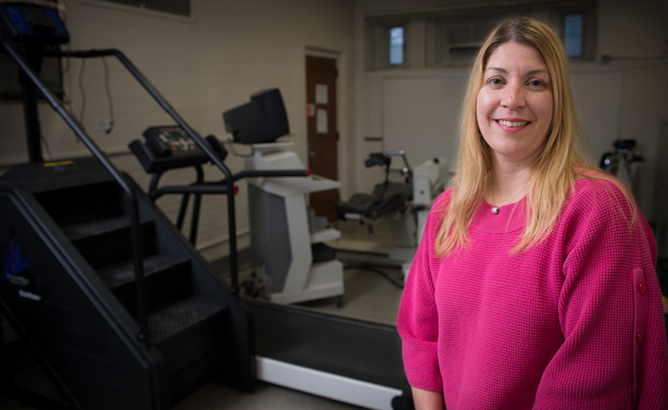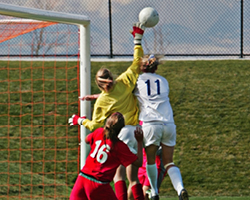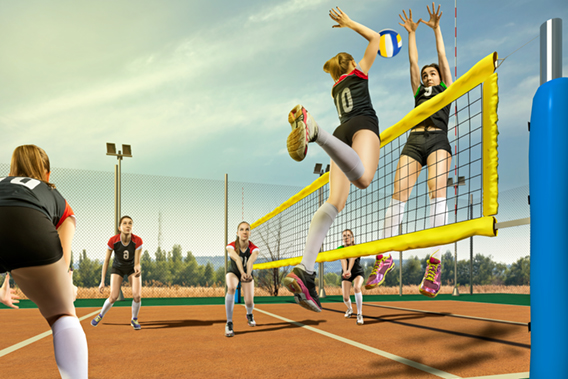Impacts of Sports-related Concussions and High School Student Athletes

Tracey Covassin is a co-director of the MSU Sports Injury Research Laboratory and leads the concussion research group, where she and her students focus on the neurocognitive and psychological effects of concussion.
- Tracey Covassin, Ph.D., FNATA, AT, ATC
- Professor, Department of Kinesiology
- Undergraduate Athletic Training Program Director
- College of Education
Concussions have long been a known risk factor for athletes who participate in hard-hitting contact sports like football and ice hockey. Impacts on the brain and the body have been in the media spotlight, especially because of stories from professional players and their families. It has triggered intense scrutiny about safety, but has also led to a slew of other questions pertaining to head injuries among men and women athletes across the sports spectrum.
Tracey Covassin leads the undergraduate athletic training program at MSU, and her major areas of study focus on sports-related concussion. Much of her work involves the diagnosis, treatment, and potential prevention of concussions for athletes. She and her students partner with athletic trainers to address standards of care for sports-related injuries, particularly concerning concussions. That includes outreach efforts such as research presentations and information sessions to address the concerns of parents, student athletes, coaches, and school administrators.
Growing up in Canada, Covassin became passionate about the Toronto Maple Leafs ice hockey team. Their fan base is known for their great loyalty, and Covassin—like others—followed the game and the players. Eric Lindros, a legendary power forward on the Philadelphia Flyers team went to the Maple Leafs, and despite his strong playing skills, Lindros suffered multiple concussions that led to significant portions of missed time on the ice.
"I became interested in these concussions during that time, somewhere back in 2000," said Covassin. "Then all this information began coming out about concussion rates among National Hockey League players. That's how it started for me—and all my students know the background," said Covassin, smiling.
What is a Concussion?

"In the old days, the kids did tough it out. We have erred on the side of safety for a long time, but the research is even more reason to take that approach," said Brian Wolcott, director of athletics and dean of students at Lansing Catholic High School.
According to the Mayo Clinic, a concussion is a traumatic brain injury that affects brain function. They can be caused by a strong blow to the head, or violently shaking or jarring the head, neck, or upper body. That can cause the brain to smash into the inner walls of the skull at a force that prevents the cerebrospinal fluid from its intended cushioning.
In an Emmy-winning video presented by Lawrence Technological University, neurologist Jeffrey Kutcher from southeast Michigan cites three individual diagnoses related to concussions. The first is the concussion itself, a temporary condition that affects the function of the brain. The second is post-concussion syndrome. This syndrome involves symptoms that can linger for days, weeks, and months after the initial injury. The patient may experience headaches, dizziness, blurry vision, memory and concentration difficulties, and other symptoms. The third is the long-term effects or complications from a concussion or multiple concussions. Findings presented at the American Association for the Advancement of Science Annual Meeting in 2013 indicated that damage to the brain caused by concussion can last for decades beyond the original injury.
Repeated blows to the head, or multiple concussions, can lead to chronic traumatic encephalopathy, a degenerative brain disease. The term emerged from players in the National Football League who suffered from the disease after years of playing the sport, but also affects male and female athletes in various sports, as well as veterans of military service.
Sports Injury Research Laboratory
After following the news about head trauma injuries among hockey players, Covassin began to question the concussion experiences of athletes across the sports spectrum, and how those experiences differed between men and women. The research integrated her background in psychology as well as her major area of study in athletic training for her Master's degree from the University of Nevada. Covassin's dissertation while attending Temple University in Philadelphia examined the gender differences and neuropsychological impairments of concussions among athletes.
Athletic training curriculum and clinical training follows the medical model, according to the National Athletic Trainers' Association (NATA). Certified and state-licensed athletic trainers are healthcare professionals who specialize in patient education to prevent injury and re-injury. They support preventative care and aim to reduce injuries and chronic conditions for patients in their care. Athletic trainers collaborate with athletes, coaches, and physicians, and work under the direction of physicians as prescribed by state licensing laws.
Covassin came to MSU in 2005 and became the undergraduate athletic training program director. She is a co-director of the Sports Injury Research Laboratory in the Department of Kinesiology, and leads the concussion research group, where she and her students focus on the neurocognitive and psychological effects of concussion, with specific focus on youth populations.
Concussion information is a timely topic. The Michigan High School Athletic Association (MHSAA) established required reporting of all head injuries sustained during MHSAA-sponsored activities beginning in the 2015-2016 school year.
"One of the biggest revelations we've had in recent years involves the fact that the second concussion can be deadly," said Tom Rashid, MHSAA associate director. "One concussion is one too many, but subsequent concussions take it to a different level of concern. It's why we became the first in the country to establish concussion insurance, covering 7th to 12th graders who experience a concussion during MHSAA-covered practices or games."

Michigan was the first state to enroll student athletes in concussion insurance offered through the Michigan High School Athletic Association. The goal is to treat concussion injuries beyond diagnosis so that youth have recovery time.
By offering the gap insurance, it gives further protection for student athletes who experience a concussion. They are then able to seek further treatment beyond diagnosis and initial treatment.
"The student athlete can only return when cleared by an M.D., D.O., physician assistant, or nurse practitioner, and it's never the same day as the injury. The safety of the student athlete is of primary importance, and we want to stop the attitude of ‘toughing it out' for the sake of the game," said Rashid.
"In the old days, the kids did tough it out. We have erred on the side of safety for a long time, but the research is even more reason to take that approach," said Brian Wolcott, director of athletics and dean of students at Lansing Catholic High School.
Concussions in women
When Covassin was beginning her research career back in 2000, she would present information to physicians, who weren't seeing concussions in females. Now that females are reporting concussions, they are doing so at a higher rate than males in sex comparable sports.
"We know from the research that females experience more concussions, and females take longer to recover," said Covassin.
Various reasons for those differences are emerging from the research, according to Covassin. It could be that females are more honest in their reporting and articulating their experiences with concussions. Neck muscles and neck girth are also weaker in females, which means the head could rotate faster when experiencing a jarring blow.
"Dr. Covassin's research has contributed to our increased knowledge and awareness of concussions in middle school and high school youth. Her work impacts our ability to communicate with coaches and parents and student athletes, and it also has contributed to our own MHSAA policies that we develop," said Kathy Vruggink Westdorp, MHSAA assistant director leading the Head Injury Reporting System.
"When I began, I would go to high schools and talk about the signs of concussed athletes—the symptoms, and risks of playing with a concussion," said Covassin. "I often use this one perfect example of what I experienced: at one session, this father raises his hand and says, ‘Are you talking about my daughter who is playing volleyball, and not my son who is playing football?' He thought that girls didn't get concussions, and that unless you're the football player, you're not going to get a concussion," said Covassin.
"We've had girls collide, hit the net poles, take a ball to the face," Covassin told the parent. "They most certainly can experience a concussion."
Better Concussion Assessments during Games and Practices
Covassin has received multiple grants from BrainScope, a medical technology manufacturer that is pursuing development of a portable EEG designed for rapid and accurate head injury assessments. The concept is driven by the need to make on the spot healthcare decisions when injuries occur. The company, based in Bethesda, Maryland, initially developed the technology with significant funding from the U.S. Department of Defense.
"The original design was packaged for the military to use in theater—for example, when someone stepped on an IED (improvised explosive device). The aim is to identify the likelihood of both structural brain injury and functional brain impairment as soon as possible after an injury occurs. This can accelerate decisions about when to risk military medical operations for pulling injured service members out of sometimes dangerous situations, and whether to transport them by air or by ground.
The FDA approved the technology device for traumatic brain injuries, and BrainScope is now pursuing testing for increased use in areas such as youth sports. Covassin and her team have been testing the device at the high school level for four years. "They know that it will pick up severe traumatic brain injuries, such as a brain bleed, but we need to find out if it will pick up milder forms. They are still analyzing the data with intent to submit to the FDA in April 2019, and we may see this technology at practices and games in the near future," said Covassin.
As for the future? "We will never be able to eliminate concussions," said Covassin. "We are reaching people with education and information that affects policies and rules and equipment that make it safer to play sports. Between the research, and our work with high school athletes, coaches, athletic trainers, and parents, we are changing the culture."
- Written by Carla Hills, University Outreach and Engagement
- Photograph courtesy of MSU Communications and Brand Strategy